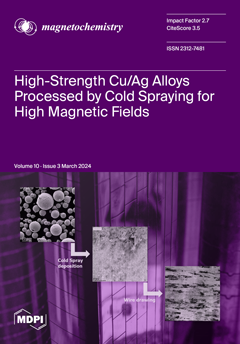The mononuclear and dinuclear ruthenium(III) complexes
trans-Ph
4P[Ru
III(acac)
2Cl
2] (
1), Ph
4P[{Ru
III(acac)Cl}
2(
μ-Cl)
3] (
2) and
trans-Ph
4P[Ru
III(acac)
2(NCS)
2]·0.5C
6H
14 (
3·0.5C
6H
14) were synthesized. Single crystals of
1,
2·H
2O and
3·CH
3CN suitable for X-ray crystal structure analyses were obtained through recrystallization from DMF for
1 and
2·H
2O and from acetonitrile for
3·CH
3CN. An octahedral Ru with bis-chelate-acac ligands and axial chlorido or
κ-
N-thiocyanido ligands (for
1 and
3·CH
3CN) and triply µ-chlorido-bridged dinuclear Ru
2 for
2·H
2O were confirmed through the structure analyses. The Ru–Ru distance of 2.6661(2) of
2·H
2O is indicative of the existence of the direct metal–metal interaction. The room temperature magnetic moments (
μeff) are 2.00 and 1.93 μ
B for
1 and
3·0.5C
6H
14, respectively, and 0.66 μ
B for
2. The temperature-dependent (2–300 K) magnetic susceptibility showed that the strong antiferromagnetic interaction (
J ≤ −800 cm
−1) is operative between the ruthenium(III) ions within the dinuclear core. In the
1H NMR spectra measured in CDCl
3 at 298 K, the dinuclear complex
2 showed signals for the acac ligand protons at 2.50 and 2.39 ppm (for CH
3) and 5.93 ppm (for CH), respectively, while
1 and
3·0.5C
6H
14 showed signals with large paramagnetic shifts; −17.59 ppm (for CH
3) and −57.01 ppm (for CH) for
1 and −16.89 and −17.36 ppm (for CH
3) and −53.67 and −55.53 ppm (for CH) for
3·0.5C
6H
14. Cyclic voltammograms in CH
2Cl
2 with an electrolyte of
nBu
4N(ClO
4) showed the Ru
III → Ru
IV redox wave at 0.23 V (vs. Fc/Fc
+) for
1 and the Ru
III → Ru
II waves at −1.39 V for
1 and −1.25 V for
3·0.5C
6H
14 and the Ru
III–Ru
III → Ru
III–Ru
IV and Ru
III–Ru
III → Ru
III–Ru
IV waves at 0.91 V and −0.79 V for
2.
Full article





